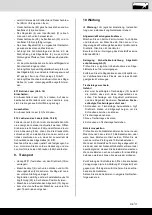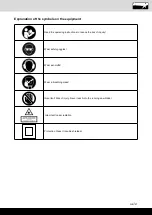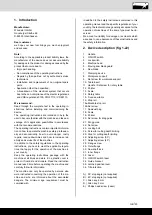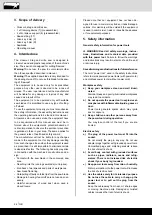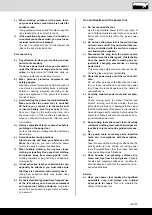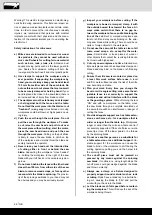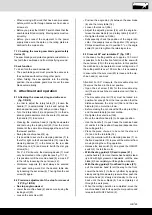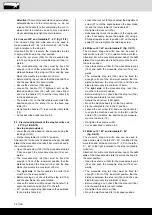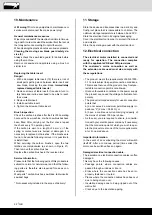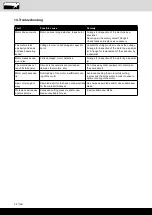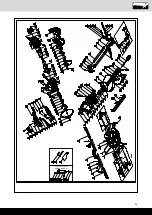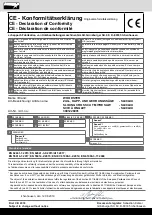
GB | 31
•
Now, using a little more force, slacken the flange
screw (29) in the clockwise direction.
•
Turn the flange screw (28) right out and remove the
outer flange (29).
•
Take the blade (6) off the inner flange (31) and pull
out downwards.
•
Carefully clean the flange screw (28), outer flange
(29) and inner flange (32).
• Fit and fasten the new saw blade (6) in reverse or-
der.
• Important! The cutting angle of the teeth, in other
words the direction of rotation of the saw blade (6)
must coincide with the direction of the arrow on the
housing.
• Before continuing your work make sure that all safe-
ty devices are in good working condition.
• Important! Every time that you change the saw
blade (6), check to see that it spins freely in the ta-
ble insert (10) in both perpendicular and 45° angle
settings.
• Important! The work to change and align the saw
blade (6) must be carried out correctly.
8.11 Using the laser (fig. 18)
Switch on:
Press the ON/OFF switch laser (33) 1x. A laser line is
projected onto the material you wish to process, pro-
viding an exact guide for the
Switch off:
Press the ON/OFF switch laser (33) 1x.
8.12 Adjusting the laser (fig. 19-20)
If the laser (32) ceases to indicate the correct cutting
line, you can readjust the laser. To do so, open the
screws (32b) and remove the front cover (32a). Loos-
en the Philips head screws (E) and set the laser by
moving sideways until the laser beam strikes the teeth
of the saw blade (6).
After adjusting and tightening the laser, mount the
front cover by tightening both screws (32b) by hand.
9. Transport
• Tighten the handle (11) to lock the rotary table.
• Press the machine head (4) downwards and secure
with the locking bolt (23).
• Fix the saw’s drag function with the locking screw
for drag guide (20) in rear position.
•
Carry the equipment by the fixed saw table (15).
• When reassembling the equipment proceed as de-
scribed under section 7.
• Release the rotary table (14) by loosening the han-
dle (11).
• Using the handle (11), set the rotary table (14) to the
desired angle (refer also to point 8.4 in this regard).
• Re-tighten the handle (11) to secure the rotary table
(14).
• Undo the set screw (22).
• Use the handle (1) to tilt the machine head (4) to the
left until it coincides with the required angle value (in
this connection see also section 8.6).
• Re-tighten the set screw (22).
• Cut as described under section 8.3.
8.8 Limiting the cutting depth (fig. 3/13)
•
The cutting depth can be infinitely adjusted using
the screw (24). To do this loosen the knurled nut
(24a) on the screw (24). Turn the screw (24) in or
out to set the required cutting depth. Then re-tighten
the knurled nut (24a) on the screw (24).
• Check the setting by completing a test cut.
8.9 Sawdust bag (fig. 1/22)
The saw is equipped with a debris bag (17) for sawdust
and chips.
Squeeze together the metal ring on the dust bag and
attach it to the outlet opening in the motor area.
The debris bag (17) can be emptied by means of a
zipper at the bottom.
Connection to an external dust extractor
• Connect the vacuum hose with the dust extraction
spout.
• The industrial vacuum cleaner must be suitable for
the material being worked.
• When vacuuming dust that is especially detrimen-
tal to health or carcinogenic, use a special vacuum
cleaner.
8.10 Changing the saw blade (fig. 1/2/14-17)
Remove the power plug!
Important!
Wear safety gloves when changing the saw blade.
Risk of injury!
• Swing the machine head (4) upwards and lock with
the locking bolt (23).
• Loosen the retaining screw (5a) of the cover using a
Philips screwdriver.
WARNING! Do not fully remove this screw.
• Fold the saw blade guard (5) upwards until the saw
blade guard (5) is above the flange screw (28).
•
With one hand insert the Allen key (C) in the flange
screw (29).
• Hold the Allen key (C) and slowly close the saw
blade guard (5) until it touches the Allen key (C).
• Firmly press the saw shaft lock (30) and slowly ro-
tate the flange screw (28) in clockwise direction.
The saw shaft lock (30) engages after no more than
one rotation.
Summary of Contents for SL90LXU
Page 4: ...4 21 22 17 20 E E E 19 32 32a 32b 32b 16 17 18 15 5 29 34 31 33 30 28 C 6...
Page 20: ...20 DE...
Page 35: ...35...

